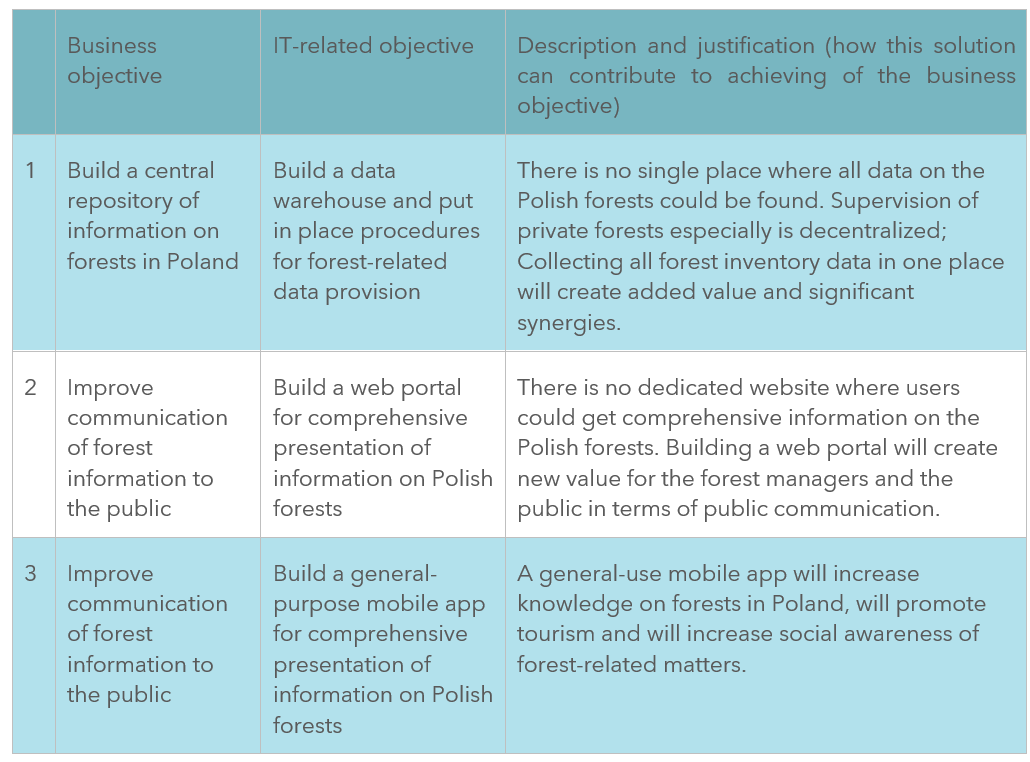Phase 1: Alignment of IT with business
Define IT-related objectives
Objective of the exercise
Business objectives defined in the context of the current policies and the forest value chain must be translated into actionable IT objectives. IT-related objectives establish clear targets and outcomes that guide the development, implementation and management of FIS, aligning them with the specific needs and goals in the context of the business objectives.
Introduction
In the context of forest information systems, defining IT-related objectives is a critical process that aligns IT projects with the overarching business objectives of the forest sector. This step ensures that the IT initiatives undertaken are purposeful and geared towards delivering specific outcomes that contribute to the achievement of broader goals. By clearly outlining the IT-related objectives, stakeholders can prioritize and plan IT projects effectively, optimizing resources and maximizing the impact of technological investments.
IT-related objectives serve as the bridge between the business objectives of the forest sector and the technical implementation of FIS. They define the specific technology-related targets and outcomes that need to be accomplished to support and enhance various activities within the sector. These objectives are framed in a manner that reflects the benefits that technology can bring to the sector's functioning and long-term growth.
By defining clear and measurable IT-related objectives within the framework of FIS, organizations can ensure that their technology projects are purpose-driven, aligned with business goals and yield tangible benefits for the forest sector and its stakeholders.
Some examples of possible IT-related objectives in the forestry sector:
- Enhanced forest monitoring and management through remote-sensing technology;
- Strengthened forest supply chain transparency with blockchain technology;
- Enabled data-driven decision-making with advanced analytics.
What are the steps in defining IT-related objectives of an FIS development programme?
The steps in defining IT-related objectives of an FIS development programme are:
- Formulating IT-related objectives;
- Validating IT-related objectives;
- Selecting candidates for intervention (optional).
Step 1. Formulation of IT-related objectives
The starting point for this exercise is the list of business objectives of the FIS programme as outlined before. They represent the possible points of intervention in the value chain to improve its functioning. They should be translated into actionable IT-related objectives. An example list of IT-related objectives formulated in the course of initiating the Forest Data Bank development in Poland is listed in figure below.

Technical solutions are not expected to be defined at this stage because this would require a detailed process and resource analysis which will be done in Phase 2. At this point, the process should focus on identifying IT-related product or solution ideas that will support the achievement of the business objectives.
For example, if a business objective was defined as providing the general public with consistent, timely and accurate information on forest resources, the corresponding IT objective could be: create a national repository to collect, store, process and publish data on forests.
Another business objective could be: to monitor and prevent illegal logging and deforestation. Its corresponding IT objectives would be: (1) create a timber-tracking system, (2) create an early-detection deforestation monitoring system.
Practical note: This step could work well when participants work in separate discussion groups with each having the same value chain map and the same list of business objectives to work with, especially if there are more than five participants. Splitting into smaller groups prevents reaching the consensus prematurely, and thus potentially silencing minority views with important insights. The groups should use sticky notes for assembling their ideas on IT-related products or solutions with a potential to help attain each business objective adding justifications. These could be placed on their copy of the value chain map, next to the respective business objective.
Step 2. Validation of the IT-related objectives
After completion of Step 1, findings should be summarized and discussed. Proposed items should be evaluated considering:
- Their relevance and alignment to the corresponding business objective, i.e. how much they can contribute to achieving the business objective;
- Effectiveness, i.e. whether they are the best imaginable solution for achieving the respective business objective; for example, if several solutions/products have been proposed, they should be evaluated and scored by their complexity, cost, etc. to identify the best one;
- Feasibility, i.e. how easy it would be to develop and maintain these particular solutions/products.
Care must be taken to ensure coherence between the proposed IT-related objectives for a FIS development programme

Practical note: Having completed the work in subgroups, the teams convene and present their ideas. The moderator keeps a table of all proposed IT-related objectives, taking notes on their pros and cons for relevance, effectiveness and feasibility
Step 3 (optional). Selecting candidates for intervention
If members of the group feel competent, they might attempt to choose IT-related objectives to address future FIS-building projects. The selection of IT-related objectives is not an easy process, as it requires attention to many factors, some of which are general (e.g. cost, availability of technology) but others are specific to the context of the overall analysis (e.g. policy priorities, available resources, organizational circumstances, governance framework).